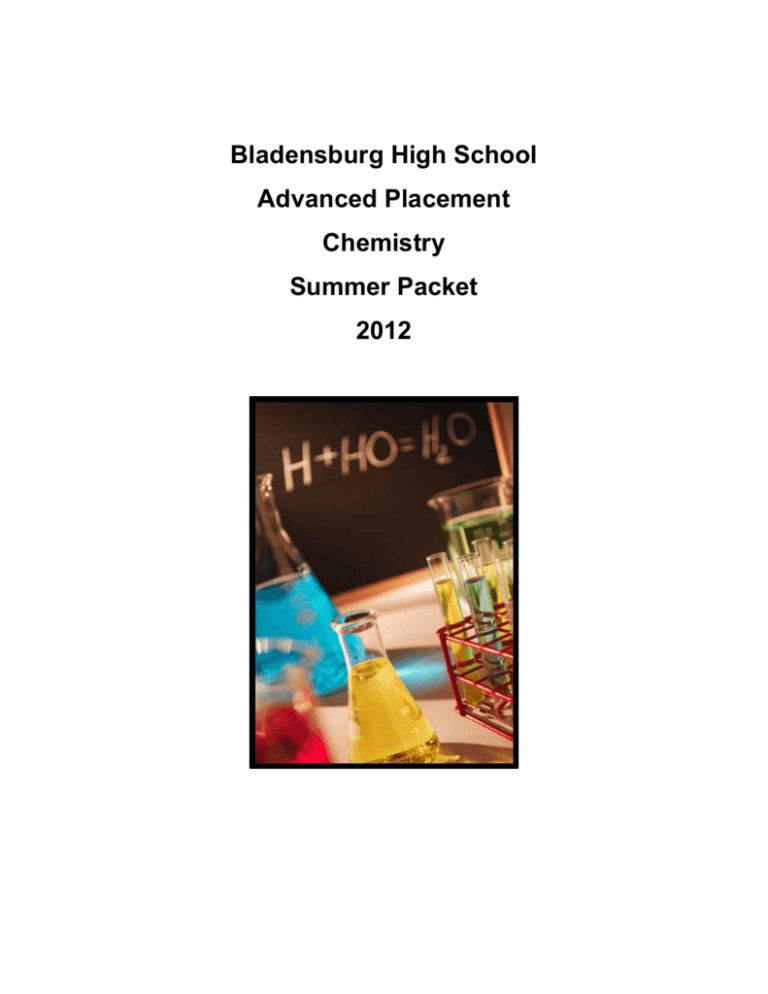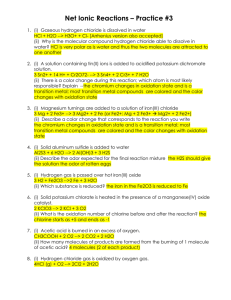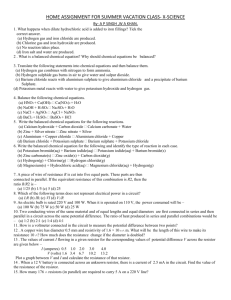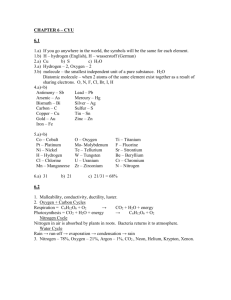Bladensburg High School Advanced Placement Chemistry Summer
advertisement

Bladensburg High School Advanced Placement Chemistry Summer Packet 2012 What is covered in Advanced Placement Chemistry The Advanced Placement course is intended to be equal to the general chemistry course usually taken during the first year of college. The topics covered in this course are listed below. • • • • • Structure of Matter States of Matter Reactions Descriptive Chemistry Laboratory In order to be successful in Advanced Placement Chemistry, it is critical to review concepts learned in chemistry. The activities included in this packet will help with your review preparation prior to taking the AP Chemistry course during the 20122013 school year. Bring your completed packet on the first day of class to address concerns and or questions regarding the activities. Remember to review the online resources and take the practice quizzes when available. Good luck and have a wonderful summer! = Worksheet 1 - Calculations Significant Figures - the number of significant figures (sig. fig.) is a measure of the degree of uncertainty in a measurement. There is experimental uncertainty in the last significant figure of a measurement. The rules for sig. fig. are given in Chapter 1.5. All non-zero numbers are significant. Zeros between numbers are significant. Zeros to the left of numbers are not significant. Zeros to the right of numbers may be significant (in presence of a decimal point). 1. Express each of the following numbers in scientific notation and decide the number of significant figures: Scientific notation 409.10 ______________ 4091.00 ______________ 0.004091 ______________ 308,000 ______________ 30,860. ______________ 0.00056030 ______________ sig.fig. _____ _____ _____ _____ _____ _____ Calculations with significant figures - In multiplication or division, the number of sig. fig. in the answer has only as many sig. fig. as the factor with the smallest number of sig. fig. which rounds to .0040 or 4.0 x 10-3 (2 sig. fig.) In addition and subtraction, the answer should be reported to the same number of decimal places as the term with the least number of decimal places. which rounds to 0.84 or 8.4 x 10-1 Do addition and subtraction first. When rounding, numbers ≥ 5 are rounded up. Do not round until the end of the calculations. 2. Do the following calculations and express the answers to the correct number of sig. fig. 29.837-29.241 = 32.064 752.12 + 26.3 = 760.00 Dimensional Analysis - This technique can be used to change units (K → oC) and also as an aid in solving problems, by carefully keeping track of units. SI Units and conversion factors are listed in Appendix 6 (A26) in the textbook. A table of metric to English conversion factors is on page 16 of the textbook. A certain process yields 4.85 x 10-2 g of a chemical product per second. How many kilograms will be produced in five days of continuous reaction? Start with what you know on the left and what you are trying to find on the right. 4.85 x 10-2 g s = kg Then find conversion factors, which allow you to change your units. Finally, determine the number of sig. fig. The first term has 3 sig. fig. All of the other factors are definitions, and have ∞ sig. fig. So, the answer will be limited to 3 sig. fig., 21.0 kg. In the conversion factors the value of the numerator and denominator are the same; 60 seconds = 1 minute, 24 hours = 1 day. The final conversion unit illustrates the use of metric prefixes; 1000 grams = 1 kilogram. It is important to know these commonly used prefixes. 3. Fill in the missing information in the following chart. Metric prefix Symbol Exponent M 10-9 deci 10-6 p kilo m 10-2 4. A volume of 520. cm3 is equivalent to: _____ mL _____ dL ______ L 5. Make the following conversions (Express your answer in scientific notation.) a. 0.0024 km to nm b. 3.5 g/dm3 to mg/mm3 c. 95 yards to cm ( 3 feet in a yard; 2.54 cm in 1 inch) 6. You feel a bit feverish and take your temperature with a lab thermometer, marked in degrees kelvin. It reads 310 K. What is your Fahrenheit temperature? [Remember (oF) = 1.8 (oC) + 32o and K = oC +273] Work on the following problems, paying attention to sig. fig. 7. Write down your height. Convert it to meters (m.) ___ft. ___in. = ____ m. 8. A child's sandbox is 4.0 ft. wide, 4.0 ft. long and 9.0 in deep. If there are, on the average, 55 grains of sand per mm3, how many grains of sand are there in the sandbox? Answer all Problems. Significant Digits 1. How many significant digits are there in each of the following quantities? a. 20 kg b. 0.0051 g c. 11 cm d. 0.010 s e. 90.4 C f. 0.004 cm g. 0.089 kg h. 100.0 C i. 20 cars 2. List the number of significant digits for each of the following. a. 1 km b. 1.5 mL c. C. 2.15 000 cm 2 d. 5.380 00 0 s Density 3. What is the density of piece of concrete that has a mass of 8.76 g and a volume of 3.07 cm3? 4. Illegal ivory is sometimes detected on the basis of density. What is the density of a sample of ivory whose volume is 14.5 cm3 and whose mass is 26.8g? 5. An archeologist finds that a piece of ancient pottery has a mass of 0.61 g and a volume of 0.26 cm3. What is the density of the pottery? 6. 5. Limestone has density of 2.72 g/cm3. What is the mass of 24.9 cm3 of limestone? 7. Calcium chloride is used as a deicer on roads in winter. It has a density of 2.50 g/cm3. What is the volume of 7.91 g of this substance? 8. Determine the density if a pine board whose dimensions are 4.05 cm by 8.85 cm by 164 cm and whose mass is 2580 g. 9. Find the density of a 51.6 g cylindrical steel rod of diameter 0.622 cm and length 22.1 cm. Name____________________________ Date_____________ Period____ Periodic Table Worksheet Use a Periodic table to find the information asked for below: 1.What is the atomic number of: Calcium____ Iron _____ Gold_____ Uranium_____ 2. What is the Atomic mass of: Calcium___ Iron_____ Uranium_____ Copper_____ 3. How many protons do the following have? 4. How many electrons do the following have? Calcium have____ Gold have____ Gold_______ Iron_____ Copper______ Copper_____ Iron______ Uranium_____ 5. Does mercury have more protons and electrons than tin? 6. Is mercury a heavier element than tin? 7. Does potassium have more electrons than neon? 8. Does hydrogen have more electrons than Uranium? 9. Which has more protons, sulfur or iodine? 10. Which has more protons, iodine or silver? 11. In the boxes below make Bohr models for each of the elements. a. Determine how many electrons, protons, and neutrons there are in each atom. b. Draw a Bohr model of each element using the number of electrons, protons, and neutrons c. NOTE: The first energy level can only hold up to 2 electrons. The second energy level can hold up to 8 electrons. _________ Electrons _________ Protons _________ Neutrons _________Electrons HELIUM _________ Protons _________ Neutrons OXYGEN 12. Study the following model of an atom and answer the following questions: - + - + + + + - - + + + + - + - Key: Particles with no charge + a. b. c. d. e. Particles with negative charge Particles with positive charge How many electrons does this atom have? _________________ How many protons? _________________ How many neutrons? ________________ What is the atomic number? ______________ Find the name of this element by referring to the periodic chart. _______________________ 13. Write the symbols or the names for each of these elements: Chlorine __________________ _______________________ Zn Copper ___________________ Helium _____________ Potassium _________________ Iron ________________ Silver ____________________ _______________________ P _____________________ Na _______________________ Ne _____________________ Sn Mercury ______________ 50 Ways to Name Your Compound All of the compounds that you will be asked to name consist of two parts… Part 1 Metal (single valent) Part 2 Non-metal Polyatomic ion Non-metal Example NaCl, CaCO3 CuCl, sodium chloride calcium carbonate copper(I) chloride Polyatomic ion Fe2(CO3)3 iron(III) carbonate (Latin/old) Non-metal or Polyatomic ion Non-metal Non-metal Fe2(CO3)3, CuCl CO2 ferric carbonate, cuprous chloride carbon dioxide Hydrogen HCl hydrogen chloride HCl(aq) hydrochloric acid H2SO4 sulphuric acid (or ammonium) Metal (multivalent) Hydrogen Non-metal Polyatomic ion Rule Name both parts, ends in -ide Name both parts Name both parts, ends in -ide, add valence after metal Name both parts, add valence after metal Metal has Latin name (ic for higher valence, ous for lower) Use Greek prefix system (mono- not used for 1st element) If not aqueous, name hydrogen and non-metal (ending in -ide) If aqueous, “hydro” + non-metal + “ic acid” Name polyatomic ion (ending is -ic instead of -ate or -ous instead of -ite), add “acid” − Note: no special naming is given for bases. These are considered as a metal + polyatomic ion (OH being a polyatomic ion) Assignment: write the corresponding name or formula for each of the following: 1. lead(II) sulfide 18. N2O3 35. barium sulfite 2. perchloric acid 19. H2SO3 36. SnCl2 3. hydrogen fluoride 20. HgO(aq) 37. CaHPO3(s) 4. zinc hydroxide 21. iron(II) nitride 38. H2S(g) 5. hydrobromic acid 22. tetraphosphorus decaoxide 39. Li2O2 6. SF6(l) 23. copper(I) oxide 40. Mn(NO2)2 7. HNO2(aq) 24. hypochlorous acid 41. mercuric phosphate 8. HCl(g) 25. potassium peroxide 42. sodium hydrogen carbonate 9. PbCl2 26. CuSO3 43. copper(I) hydrogen sulfate 10. ZnSO4 27. CO 44. carbon tetrachloride 11. ammonium carbonate 28. MgS 45. ammonium phosphate 12. chromium(III) sulfite 29. KClO2 46. SO2(aq) 13. nickel(II) sulfate hexahydrate 30. HI(aq) 47. MgSO4·9H2O 14. hydrosulfuric acid 31. nitrogen trichloride 48. HC2H3O2 15. sulfur trioxide 32. plumbic carbonate 49. P2O3 16. H2CrO4 33. potassium hydrogen sulfite 50. H3PO3 17. A12O3 34. boric acid Balancing Chemical Equations Worksheet 1. _____ H2 + _____ O2 Æ _____ H2O 2. _____ N2 +_____ H2 Æ_____ NH3 3. _____ S8 + _____ O2 Æ _____ SO3 4. _____ N2 + _____ O2 Æ _____ N2O 5. _____ HgO Æ _____ Hg + _____ O2 6. _____ CO2 + _____ H2O Æ _____ C6H12O6 + _____ O2 7. _____ Zn + _____ HCl Æ _____ ZnCl2 + _____ H2 8. _____ SiCl4 + _____ H2O Æ _____ H4SiO4 + _____ HCl 9. _____ Na + _____ H2O Æ _____ NaOH + _____ H2 10. _____ H3PO4 Æ _____ H4P2O7 + _____ H2O 11. _____ C10H16 + _____ Cl2 Æ _____ C + _____ HCl 12. _____ CO2 + _____ NH3 Æ _____ OC(NH2)2 + _____ H2O 13. _____ Si2H3 + _____ O2 Æ _____ SiO2 + _____ H2O3 14. _____ Al(OH)3 + _____ H2SO4 Æ _____ Al2(SO4)3 + _____ H2O 15. _____ Fe + _____ O2 Æ _____ Fe2O3 16. _____ Fe2(SO4)3 + _____ KOH Æ _____ K2SO4 + _____ Fe(OH)3 17. _____ C7H6O2 + _____ O2 Æ _____ CO2 + _____ H2O 18. _____ H2SO4 + _____ HI Æ _____ H2S + _____ I2 + _____ H2O 19. _____ FeS2 + _____ O2 Æ _____ Fe2O3 + _____ SO2 20. _____ Al + _____ FeO Æ _____ Al2O3 + _____ Fe 21. _____ Fe2O3 + _____ H2 Æ _____ Fe + _____ H2O 22. _____ Na2CO3 + _____ HCl Æ _____ NaCl + _____ H2O + _____ CO2 23. _____ K + _____ Br2 Æ _____ KBr 24. _____ C7H16 + 25. _____ P4 + _____ O2 Æ _____ P2O5 _____ O2 Æ _____ CO2 + _____ H2O 26. Dicarbon dihydride + Oxygen Æ Carbon dioxide + Water 27. Potassium oxide + Water Æ Potassium hydroxide 28. Hydrogen peroxide Æ Water + Oxygen 29. Aluminum + Oxygen Æ Aluminum oxide 30. Sodium peroxide + Water Æ Sodium hydroxide + oxygen 31. Silicon dioxide + Hydrogen fluoride Æ Silicon tetrafluoride 32. Carbon + water Æ Carbon monoxide + Hydrogen 33. Potassium chlorate Æ Potassium chloride 34. Potassium chlorate Æ Potassium perchlorate + Potassium chloride 35. Aluminum sulfate + Calcium hydroxide Æ Aluminum hydroxide + Calcium sulfate 36. Tetraphosphorus decoxide 37. Iron III chloride + Ammonium hydroxide Æ Iron III hydroxide + Ammonium chloride 38. Antimony + Oxygen Æ Tetrantimony Hexoxide 39. Tricarbon octahydride + Oxygen Æ Carbon dioxide + water 40. Dinitrogen pentoxide + Water Æ Hydrogen nitrate 41. Nitrogen trihydride + Nitrogen monoxide Æ Nitrogen + Water 42. Aluminum + Hydrogen chloride Æ Aluminum chloride + Hydrogen 43. Phosphorus pentachloride + water Æ Hydrogen chloride + Hydrogen phosphate 44. Magnesium + Nitrogen Æ Magnesium nitride 45. Iron + Water Æ Iron III oxide + Hydrogen 46. Sodium hydroxide + Chlorine Æ Sodium chloride + Sodium hypochlorite + water 47. Lithium oxide + Water Æ Lithium hydroxide 48. Ammonium nitrate Æ Dinitrogen monoxide + water 49. Lead II nitrate Æ Lead II oxide + Nitrogen dioxide + Oxygen 50. Calcium chlorate Æ Calcium chloride + Oxygen + Water + Oxygen + Water Æ Hydrogen phosphate Balancing Chemical Equations Worksheet 1. _____ H2 + _____ O2 Æ _____ H2O 2. _____ N2 +_____ H2 Æ_____ NH3 3. _____ S8 + _____ O2 Æ _____ SO3 4. _____ N2 + _____ O2 Æ _____ N2O 5. _____ HgO Æ _____ Hg + _____ O2 6. _____ CO2 + _____ H2O Æ _____ C6H12O6 + _____ O2 7. _____ Zn + _____ HCl Æ _____ ZnCl2 + _____ H2 8. _____ SiCl4 + _____ H2O Æ _____ H4SiO4 + _____ HCl 9. _____ Na + _____ H2O Æ _____ NaOH + _____ H2 10. _____ H3PO4 Æ _____ H4P2O7 + _____ H2O 11. _____ C10H16 + _____ Cl2 Æ _____ C + _____ HCl 12. _____ CO2 + _____ NH3 Æ _____ OC(NH2)2 + _____ H2O 13. _____ Si2H3 + _____ O2 Æ _____ SiO2 + _____ H2O3 14. _____ Al(OH)3 + _____ H2SO4 Æ _____ Al2(SO4)3 + _____ H2O 15. _____ Fe + _____ O2 Æ _____ Fe2O3 16. _____ Fe2(SO4)3 + _____ KOH Æ _____ K2SO4 + _____ Fe(OH)3 17. _____ C7H6O2 + _____ O2 Æ _____ CO2 + _____ H2O 18. _____ H2SO4 + _____ HI Æ _____ H2S + _____ I2 + _____ H2O 19. _____ FeS2 + _____ O2 Æ _____ Fe2O3 + _____ SO2 20. _____ Al + _____ FeO Æ _____ Al2O3 + _____ Fe 21. _____ Fe2O3 + _____ H2 Æ _____ Fe + _____ H2O 22. _____ Na2CO3 + _____ HCl Æ _____ NaCl + _____ H2O + _____ CO2 23. _____ K + _____ Br2 Æ _____ KBr 24. _____ C7H16 + 25. _____ P4 + _____ O2 Æ _____ P2O5 _____ O2 Æ _____ CO2 + _____ H2O 26. Dicarbon dihydride + Oxygen Æ Carbon dioxide + Water 27. Potassium oxide + Water Æ Potassium hydroxide 28. Hydrogen peroxide Æ Water + Oxygen 29. Aluminum + Oxygen Æ Aluminum oxide 30. Sodium peroxide + Water Æ Sodium hydroxide + oxygen 31. Silicon dioxide + Hydrogen fluoride Æ Silicon tetrafluoride 32. Carbon + water Æ Carbon monoxide + Hydrogen 33. Potassium chlorate Æ Potassium chloride 34. Potassium chlorate Æ Potassium perchlorate + Potassium chloride 35. Aluminum sulfate + Calcium hydroxide Æ Aluminum hydroxide + Calcium sulfate 36. Tetraphosphorus decoxide 37. Iron III chloride + Ammonium hydroxide Æ Iron III hydroxide + Ammonium chloride 38. Antimony + Oxygen Æ Tetrantimony Hexoxide 39. Tricarbon octahydride + Oxygen Æ Carbon dioxide + water 40. Dinitrogen pentoxide + Water Æ Hydrogen nitrate 41. Nitrogen trihydride + Nitrogen monoxide Æ Nitrogen + Water 42. Aluminum + Hydrogen chloride Æ Aluminum chloride + Hydrogen 43. Phosphorus pentachloride + water Æ Hydrogen chloride + Hydrogen phosphate 44. Magnesium + Nitrogen Æ Magnesium nitride 45. Iron + Water Æ Iron III oxide + Hydrogen 46. Sodium hydroxide + Chlorine Æ Sodium chloride + Sodium hypochlorite + water 47. Lithium oxide + Water Æ Lithium hydroxide 48. Ammonium nitrate Æ Dinitrogen monoxide + water 49. Lead II nitrate Æ Lead II oxide + Nitrogen dioxide + Oxygen 50. Calcium chlorate Æ Calcium chloride + Oxygen + Water + Oxygen + Water Æ Hydrogen phosphate Stoichiometry Worksheet 1. Na2SIO3 (s) + 8 HF(aq) H2SiF6 (aq) + 2 NaF(aq) + 3 H2O (l) a. How many moles of HF are needed to react with 0.300 mol of Na2SiO3? b. How many grams of NaF form when 0.500 mol of HF reacts with excess Na2SiO3? c. How many grams of Na2SiO3 can react with 0.800 g of HF? 2. C6H12O6 (aq) 2 C2H5OH (aq) + 2 CO2 (g) a. How many moles of CO2 are produced when 0.400 mol of C6H12O6 reacts in this fashion? b. How many grams of C6H12O6 are needed to form 7.50 g of C2H5OH? c. How many grams of CO2 form when 7.50 g of C2H5OH are produced? 3. Fe2O3 (s) + CO (g) Fe(s) + CO2 (g) (unbalanced!) a. Calculate the number of grams of CO that can react with 0.150 kg of Fe2O3 b. Calculate the number of grams of Fe and the number of grams of CO2 formed when 0.150 kg of Fe2O3 reacts 4. 2 NaOH (s) + CO2 (g) Na2CO3 (s) + H2O (l) a. Which reagent is the limiting reactant when 1.85 mol NaOH and 1.00 mol CO2 are allowed to react? b. How many moles of Na2CO3 can be produced? 5. C6H6 + Br2 C6H5Br + HBr a. What is the theoretical yield of C6H5Br in this reaction when 30.0 g of C6H6 reacts with 65.0 g or Br2? b. If the actual yield of C6H5Br was 56.7 g, what is the percent yield? Solubility Complete all activities. Activity 1 Go to the site listed below which is a tutorial on precipitation reactions. Follow all directions. You will be required to hand in a sheet of paper that has each of the three chemical reactions that you will perform during this tutorial. Record the complete molecular reaction for each combination of solutions you mix. Identify the precipitate (name and formula) produced. 9 www.wisc-online.com/objects/index_tj.asp?objID=GCH2904 Activity 2 Go to the site below and mix two solutions at a time. Write the complete molecular equations for each combination of solutions. Identify the precipitate (name and formula) that is produced. (You should have three reactions when you are finished.) 9 www.mhhe.com/physsci/chemistry/animations/chang_7e_esp/crm3s2_3.s wf Advanced Placement Chemistry Online Resources Significant Figures http://www.chem.sc.edu/faculty/morgan/res ources/sigfigs/index.html Writing Formulas and Balancing Equations • http://funbasedlearning.com/chemistr y/chemBalancer/default.htm • http://www.chymist.com/Formulas.pdf Stoichiometry, Empirical and Molecular Formula review Read chapter 10 & 12 in the textbook online at www.phschool.com . Enter code: cae0611 to access the textbook. Answer the following practice problems and show your work. • • • • • • • Useful Chemistry sites http://chemteam.info/ChemTeamInde x.html www.chemmybear.com http://www.sciencegeek.net/APchemi stry/index.shtml http://www.chem4kids.com/ Practice problems numbers 36-39 on pages 310-312 Practice problems numbers 11-14 on pages 360-361 Practice problems numbers 15 - 18 on pages 365-366 Videos (very helpful if you are having trouble understanding the concepts) • http://docott.com/files.141/screencast s/ • http://www.gpb.org/chemistryphysics/chemistry/603 Quizzes http://www.adriandingleschemistrypages.co m/apquiz.html








